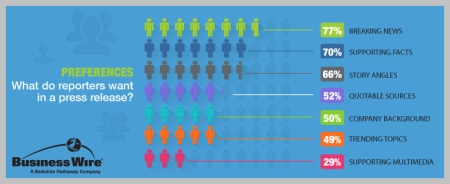By Serena Ehrlich, Director of Social & Evolving Media, Business Wire
Earlier this year, Business Wire asked reporters worldwide their preference for being pitched – from the type of news they prefer, to best practices for continuing relationships after coverage was secured.
The results of the Business Wire 2015 North American Media Survey provide a strong road map for communicators to follow when looking to increase the visibility of their organization via news coverage.
Click here to download the full survey results now: http://bit.ly/1hOkatq
 Step 1: Write an interesting release
Step 1: Write an interesting release
This may sound easy enough, but in order to catch a reporter’s attention, your news release needs to contain the information they want to cover.
When you craft your next news release, focus on the breaking news and interesting story angles as well as quotes to increase the likelihood of pick up.
Step 2: Multimedia is no longer optional
As more and more reporters are providing news content for online sources, there is a growing need for multimedia. What kind of multimedia? The element most preferred is a photographic with graphics, videos, infographics, logos and audio files rounding out the list.
Why is multimedia so important? As we discuss in Let’s Get Visual, multimedia elements allow readers to engage and absorb information in new ways, building deeper emotional connections between the reader and the news story. And reporters are not just relying on you to provide them with supporting multimedia – more than 64% of reporters are creating their own to supplement content.
In short, if you want to tell your story in your voice, supply reporters with multimedia to ensure the highest possible adoption of your news.
Step 3: Your News Release Distribution Service Matters
News distribution services such as Business Wire play an important role in the news ecosystem. 63% of media respondents noted that their jobs would be harder without newswires to vet and deliver news releases. Commercial newswires provide media outlets with an ongoing stream of trusted, breaking news in a variety of formats, allowing reporters to access and produce news coverage throughout the day. And what newswire do media outlets trust the most? At 67%, Business Wire continues to be the top newswire of choice for today’s media.
Step 4: Social Pitching is Not Advised
Despite the use of social media for research purposes or for identifying hot news trends, 75% of reporters said they do not want to receive pitches via social media
Rather than pitch reporters via social channels, use the channels to identify who is writing about your industry and to gain a better understanding to the types of news your top reporters are interested in writing and sharing with their readers.
Step 5: The Role of Your Online Newsroom
Where do reporters turn to research your pitch? Your online newsroom!
When breaking news hits the reporter’s desk, the next step is for the reporter to research the news, the company and the impact your news has on their readers. 77% of reporters turn to company online newsrooms to find the information they need to turn your news release into a headline. Frequently updated newsrooms provide reporters, and other interested parties, on-demand access to the news releases, multimedia and other branded content – perfect for reporters responsible for writing news stories in a 24/7 world.
Bonus tip? Share your coverage!
The top metric for judging the success of a news story continues to be inbound traffic to that piece. Help reporters meet this metric by creating a strong coverage sharing program to not only increase views, but awareness of your news.
Securing coverage in a selfie world is not easy, but by following the steps provided in the 2015 Business Wire Media Survey you can build stronger relationships with your key media targets and increase the chance to receive more media coverage.
Click here to share these survey results on Twitter: http://ctt.ec/3Cyhv
Download the complete 2015 Business Wire Media Survey now: http://bit.ly/1hOkatq



 Posted by Serena Ehrlich, Director of Social & Evolving Media
Posted by Serena Ehrlich, Director of Social & Evolving Media 














